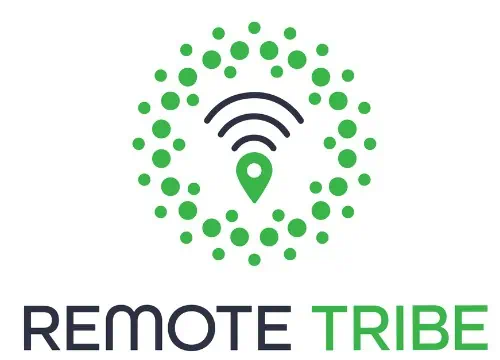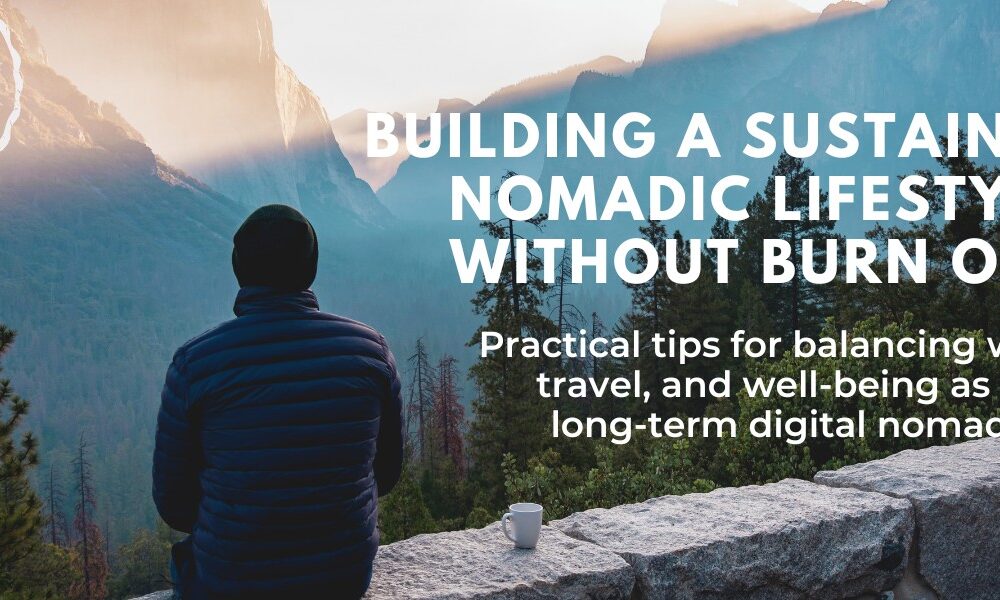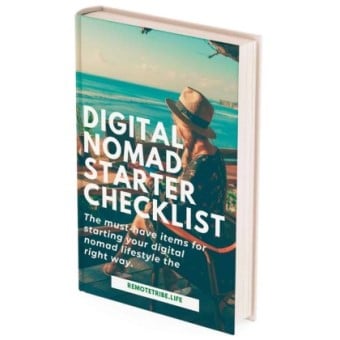The digital nomad lifestyle frequently gets glamorized with solar-soaked seashores, pc-pleasant cafés, and Instagram-worthy adventures. But behind the curated snapshots is a truth that many do not talk about—burnout, instability, loneliness, and fatigue. While faraway work has made it simpler than ever to live and work from anywhere in the world, preserving that way of life sustainably is a whole one-of-a-kind story.
Whether you’re simply beginning your nomadic adventure or are years into hopping among time zones, constructing a healthy, sustainable lifestyle is essential. Without a robust foundation, the very freedom that attracted you to this lifestyle can quickly lead to burnout. Let’s discover the way to create a long-term, balanced, and fulfilling life as a digital nomad—without crashing and burning.
Table of Contents
Redefining Freedom: The Digital Nomad Mindset
Before diving into logistics, it is important to set up the proper mindset. Freedom, frequently the core cost for virtual nomads, isn’t always pretty much reserving one-manner tickets and working from Bali—it’s about designing a life you don’t want a holiday from.
This shift calls for rethinking the way you measure fulfillment. Instead of focusing solely on how many countries you’ve visited, focus on on how you are managing your fitness, building relationships, saving for the destiny, and attaining professional boom.
Ask yourself:
Are you surely residing intentionally, or simply reacting to your surroundings?
Are your habits contributing to your long-term desires, or are they simply immediate pleasures?
Creating a sustainable nomadic lifestyle starts with defining what “freedom” looks like for you.
Prioritize Your Health—It’s Non-Negotiable
Burnout doesn’t always come from overwork. It can stem from bad vitamins, lack of sleep, a steady journey, and neglecting intellectual health. Here’s a way to keep your bodily and mental health in test on the road:
Sleep Consistency
Jet lag, changing time zones, and moving environments can wreak havoc on your circadian rhythm. Whenever possible, live for a minimum of a few weeks everywhere you go. This permits your frame to settle into an ordinary state and improves your perception of sleep.
Invest in proper earplugs, a sleep mask, and blackout curtains. Apps like Sleep Cycle or Calm permit you to analyze your patterns in unusual environments.
Nutrition on the Go
Living off avenue food and café croissants may be an adventurous experience, but it’s not sustainable nor healthy. Many nomads fall into the bad eating behavior because of convenience or price range constraints.
Learn to cook a few healthy meals, even in those small Airbnb kitchens. Visit neighborhood markets for fresh produce. Also, recollect supplements if you’re not getting enough nutrients out of your tour-based weight loss plan..

Move Your Body
It’s smooth to neglect a workout while you’re hopping from one region to some other. You don’t need a gym—bodyweight exercises, yoga, or maybe strolling lengthy distances can do the trick. How about running or bouldering? For this, you’ll just need an extra pair of shoes with you (not easy as a nomad, but doable)
Try to set up a recurring fitness routine you can adapt to any surroundings. For instance, a 20-minute morning exercise using resistance bands and YouTube videos can work in a tiny room or by way of the seaside.
Mental Health Check-Ins
Isolation, decision fatigue, and pressure from continuously adapting to new places can erode your “mental” fitness. Schedule regular calls with buddies or your family. Consider therapy—many therapists offer far-flung periods, and systems like BetterHelp or Talkspace make it less difficult than ever.
Practice mindfulness, journaling, or breathwork to ground yourself. Living within the gift isn’t just a cliché—it’s a talent that can prevent burnout
Subscribe to our Newsletter
Get The Latest News On Digital Nomad Lifestyle, Remote Working Communities
And Much More.
100% spam free. We never share your email address. Unsubscribe anytime!
Design Your Work Schedule Like a Pro
Many digital nomads fall into two camps: overworking or underworking. Either you’re grinding at your laptop for 12 hours a day in a paradise you don’t get to revel in, or you’re continuously distracted by way of the following tour, leading to missed deadlines and strain.
The key to balance is structure.
Establish Time Blocks
Design a weekly schedule that consists of conscious hours, breaks, and non-negotiable time without work. Tools like Notion, Google Calendar, or Sunsama can assist in mapping out your day. Time-blocking helps make certain you’re efficient without being crushed.
Align Work Hours with Your Location
If your clients or team are in a specific time zone, you’ll need to house their schedules. That doesn’t mean running at 3 a.m. Every night. Set clear expectations and communicate your availability.
If you are in Thailand but dealing with U.S. customers, you may work late evenings and experience your mornings and afternoons exploring.
Take Advantage of “Deep Work” Windows
Use your most efficient hours for excessive-consciousness duties. Whether you’re a morning man or woman or night owl, reserve those times for your most demanding work—and schedule calls or emails at some point for less targeted instances.
Choose Destinations Wisely

Not all journey destinations are created equal during our digital nomad lifestyle. Fast Wi-Fi, a sturdy network, secure neighborhoods, and low-cost fees for acommodation are vital for sustainability.
Factors to Consider:
- Internet Reliability: Research ahead using sources like Nomad List or Facebook groups.
- Visa Policies: Some countries offer special digital nomad visas, like Portugal, Estonia, and Costa Rica.
- Healthcare Access: Always know where the closest medical institution or health center is. Consider worldwide medical insurance with special digital nomad insurances like Genki.
- Time Zone Compatibility: Choose regions that align with your customers’ or employer’s operating hours, if needed.
Staying in one region for one to three months at a time can make lifestyles less complicated and more enriching than town-hopping every few days.
Community: The Antidote to Loneliness
One of the most underrated components of sustainable digital nomad existence is having meaningful relationships. Thme way of life can be isolating, especially when you’re continuously saying goodbye to people you’ve just met.
Build a Tribe
Join co-working spaces, attend meetups, and interact with neighborhood activities. Apps like Meetup, Bumble BFF, or Facebook expat corporations can connect you with others in the same boat.
Being around different digital nomads can also inspire you and offer emotional support.
Financial Planning for the Long Haul
Freedom loses its shine when your bank account is running dry. Sustainability requires a long-term monetary approach—not simply making enough to live on, but building in the direction of a secure future.
Build a Financial Safety Net
Create an emergency fund with a minimum of 3-6 months of dwelling fees. Nomadic lifestyles come with sudden costs—ignored flights, visa troubles, tech breakdowns, or medical emergencies.
Automate Savings & Investments
Set up vehicle transfers to a savings account or funding platform. Just due to the fact you’re nomadic doesn’t mean you can’t build wealth.
Use online banking and budgeting equipment like Wise, Revolut, or YNAB (You Need A Budget) to manipulate multi-currency income and fees.
Keep Credit in Mind
Nomads frequently forget their credit score at the same time as residing overseas. If you plan to calm down one day—maybe to buy a domestic—you’ll need a strong credit score history. That’s why it’s wise to hold U.S.-primarily based money owed and use credit cards that provide travel perks.
Speaking of settling down, when the time comes to transition from a nomadic existence to a more rooted way of life, knowing how to work with mortgage lenders can be precious. Good monetary habits on the street can make the home-buying system smoother while you’re ready to plant roots.
Planning for the future doesn’t restrict your freedom—it empowers it.
The concept of living and operating from anywhere in the world is a dream that an increasing number of humans are making a reality. With just a computer and a great Wi-Fi connection, digital nomads are constructing careers while exploring the globe. But behind the Instagram-worthy images and distinct locations, there’s a much less glamorous facet that many don’t talk about: burnout.
When your workplace is constantly changing and your timetable is self-made, it’s easy to push your limits. Lack of shape, risky income, and social isolation can take a toll on your physical and mental health. The key to thriving in the long term as a digital nomad isn’t just freedom—it’s sustainability. Here’s how to construct a lifestyle that helps your wanderlust and your well-being.
1. Establish a Routine Wherever You Are
One of the largest challenges of nomadic life is the shortage of consistency. Changing time zones, environments, and cultures can disrupt your focus and productivity. While flexibility is remarkable, an excessive amount of it may make you feel unmoored.
Creating a daily routine helps you live grounded. Wake up at a regular time, block out painting hours, and make space for meals, workouts, and relaxation. Having set behavior, even while on the street, gives your mind balance in unexpected surroundings. It’s ok to conform based totally on region; however, the foundation of your ordinary has to live intact.
2. Make Your Health a Priority
Burnout frequently stems from ignoring fundamental health needs. When you are constantly on the move, it’s easy to pass up food, lose sleep, or forget about exercising. But your frame of mind needs to be in top form to address the needs of a cell lifestyle.
Sleep Smart
Invest in good sleep gear: a travel pillow, blackout mask, and the best earplugs. Try to stay in one vicinity for at least a few weeks to permit your body to regulate to the time zone and surroundings.
Eat Well
While trying neighborhood delicacies is one of the great things about touring, your body still needs stability. Find grocery shops or markets and prepare your own meals if you can. Stock up on healthy snacks, and don’t forget supplements to fill any dietary gaps.
Move Daily
You don’t need a gym—bodyweight workouts, yoga, or lengthy walks can keep you in shape. Apps like FitOn or Nike Training Club can manual your fitness habits, even in small hotel rooms or Airbnbs.
3. Set Clear Work Boundaries
Digital nomad burnout doesn’t constantly come from running too little—it frequently comes from working an excessive amount. When your activity travels with you, it’s tempting to test in constantly, answer emails at midnight, or in no way completely clock out.
Set limitations between work and play. Establish work hours, and don’t be afraid to show off notifications outdoor of those hours. Let customers or team members recognize your availability, especially in case you’re in an extraordinary time zone. Just due to the fact you’re in paradise doesn’t mean you have to be effective 24/7.
4. Choose Destinations That Support Your Lifestyle
Not every region is digital-nomad friendly. While it may sound exciting to work from a hammock at the seaside, your Wi-Fi wishes, finances, and visa status are greater vital than the view.
Do Your Research
Check resources like Nomad List to evaluate net velocity, protection, cost of residing, and coworking options. Cities like Lisbon, Chiang Mai, and Medellín are famous for precise motives—they offer low-priced dwellings, superb infrastructure, and integrated groups.
Think Long-Term
Bouncing between towns every few days is arduous. Instead, adopt a sluggish journey mindset. Staying in one location for a month or more offers you time to build a rhythm and decrease the stress of steady travel.
If you want to become a digital nomad or find your crew, sign up for our free newsletter and get upcoming articles straight to your inbox!
We’ve got some great content on our Instagram and on our Facebook Group too where you can network with other nomads from all over the world.
5. Build a Support System
Loneliness is a silent contributor to burnout. While you may meet new human beings everywhere you go, it’s tough to build deep, lasting relationships on the pass.
Connect with Other Nomads
Join coworking areas, attend meetups, or use apps like Meetup and Bumble BFF to discover like-minded people. Having buddies who understand the lifestyle helps with emotional support and release some of the anxiety.
Stay in Touch Back Home
Schedule normal calls with family and antique buddies. Even a 20-minute chat can help you experience connectedness and reduce the feeling of isolation.
6. Stay Financially Healthy
Financial stress can quickly drain your energy and motivation. To keep away from this, create a strong money mindset and manage your cash with a plan.
Diversify Your Income
Don’t depend upon one income (job) or activity. If you’re freelancing, bear in mind multiple clients, passive income via digital merchandise, or far-off agreement work.
Track Your Budget
Use apps like YNAB or Revolut to manage your costs in one-of-a-kind currencies. Keep an emergency fund for unexpected fees like medical payments, overlooked flights, or tech failures.
Plan for the Future
Even as a nomad, it’s wise to assume long-term. You would possibly decide to calm down in the future or put money into an asset. Maintaining an amazing credit score rating and a relationship with mortgage creditors now assists you to transition smoothly when the time comes.
Final Thoughts
The virtual nomad way of life is now not a fringe trend—it’s a legitimate, ideal way to live and develop. But in case you don’t take care of yourself, set barriers, and plan strategically, you will burn out sooner or later.
Sustainability is not only about slowing down; it’s also about moving ahead with goals and plans.
Build connections that help you. Structure your work so you’re thriving, no longer just surviving. That’s the kind of freedom really worth chasing.
Your Travel Resources Handy In One Place 🗺️
🧳 Travel Insurance
Enjoy peace of mind during traveling and don’t leave your country without good travel insurance. We recommend Insured Nomads or Genki for international travel insurance.
💰Travel Finances
Get your travel finances smart and straight with Wise or Revolut.
🏨 Accommodations
For a short stay check out Booking or Agoda. Staying longer? Take a look at the offers at Airbnb. Hostels are the cheapest option that you can explore at Hostelworld.
🏡 Recommended places for long-term stay
Wanna know the accommodations where we lived during our digital nomad journey? Check out the places we enjoyed the most!
🎫 Book tours
Are you up for taking part in epic guided tours? Book ones you like using GetYourGuide or Viator.
🚗 Rent a car
To find great rental car deals check out Rental Cars and get ready for your car trip!
✈️ Book a flight
For the hottest deals check out Skyscanner, Kayak, Google Flights or WayAway.
🛡️ VPN
To stay safely connected while traveling, don’t forget about a good VPN. We recommend Surfshark or NordVPN.








No Comment! Be the first one.